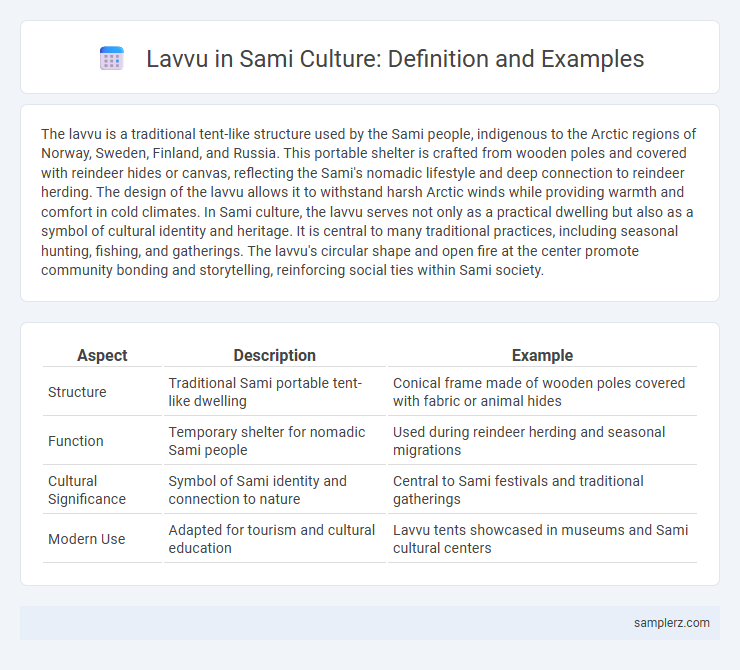The lavvu is a traditional tent-like structure used by the Sami people, indigenous to the Arctic regions of Norway, Sweden, Finland, and Russia. This portable shelter is crafted from wooden poles and covered with reindeer hides or canvas, reflecting the Sami's nomadic lifestyle and deep connection to reindeer herding. The design of the lavvu allows it to withstand harsh Arctic winds while providing warmth and comfort in cold climates. In Sami culture, the lavvu serves not only as a practical dwelling but also as a symbol of cultural identity and heritage. It is central to many traditional practices, including seasonal hunting, fishing, and gatherings. The lavvu's circular shape and open fire at the center promote community bonding and storytelling, reinforcing social ties within Sami society.
Table of Comparison
| Aspect | Description | Example |
|---|---|---|
| Structure | Traditional Sami portable tent-like dwelling | Conical frame made of wooden poles covered with fabric or animal hides |
| Function | Temporary shelter for nomadic Sami people | Used during reindeer herding and seasonal migrations |
| Cultural Significance | Symbol of Sami identity and connection to nature | Central to Sami festivals and traditional gatherings |
| Modern Use | Adapted for tourism and cultural education | Lavvu tents showcased in museums and Sami cultural centers |
Introduction to Lavvu in Sámi Culture
The lavvu is a traditional Sami tent-like dwelling used for centuries by the indigenous Sami people of Northern Scandinavia and Russia. Constructed from wooden poles covered with reindeer hides or fabric, the lavvu is designed to withstand harsh Arctic climates while providing portability for the nomadic Sami lifestyle. This iconic structure symbolizes Sami cultural heritage, reflecting their deep connection to nature, craftsmanship, and survival in subarctic environments.
Historical Significance of the Lavvu
The lavvu, a traditional Sami tent, holds profound historical significance as a portable and durable shelter adapted to the nomadic lifestyle of the Sami people in Northern Scandinavia. Its conical shape and wooden poles are designed to withstand harsh Arctic weather, enabling the Sami to maintain their reindeer herding practices across vast territories. The lavvu symbolizes Sami resilience and cultural identity, preserving ancestral knowledge and communal living traditions.
Traditional Construction of the Lavvu
The lavvu, a traditional temporary dwelling of the Sami people, exemplifies indigenous architecture adapted for Arctic conditions. Constructed using a conical framework of wooden poles covered with reindeer hides or canvas, the design allows efficient heat retention and resistance to harsh winds. This portable structure reflects the Sami's deep understanding of sustainable building techniques aligned with their nomadic reindeer-herding lifestyle.
Symbolism of the Lavvu Among the Sámi
The lavvu, a traditional Sami tent, symbolizes a strong connection to nature and nomadic heritage within Sami culture. Its circular design represents unity and the cyclical nature of life, reinforcing communal bonds essential in Sami society. As a portable shelter, the lavvu embodies adaptability and resilience, reflecting the Sami's harmonious relationship with their Arctic environment.
Daily Life and Activities Inside the Lavvu
The lavvu, a traditional Sami tent, serves as a central element in daily life, providing shelter and a communal space for cooking, resting, and socializing. Inside the lavvu, families gather around an open fire for warmth and to prepare meals, fostering a strong sense of community and cultural continuity. This portable dwelling reflects the Sami's deep connection to their nomadic reindeer herding lifestyle and the Arctic environment.
Lavvu in Sámi Rituals and Celebrations
The lavvu serves as a central symbol in Sami rituals and celebrations, embodying traditional nomadic life and spiritual connection to nature. Used during seasonal ceremonies and communal gatherings, the lavvu provides shelter while fostering a space for storytelling, joik singing, and cultural continuity. Its conical design reflects Sami craftsmanship, representing resilience and unity within Sami culture.
Differences Between Lavvu and Other Structures (Yurt, Tipi)
The lavvu, a traditional Sami tent, differs significantly from yurts and tipis in both structure and cultural use. Unlike the circular, lattice-framed yurt, the lavvu features a simpler, conical design with straight poles leaning inward and a smaller footprint, reflecting the nomadic reindeer herding lifestyle of the Sami people. The tipi, common among Native American tribes, uses a similar conical shape but employs smoke flaps and a different pole arrangement, showing distinct adaptation to North American plains compared to the Scandinavian Arctic environment where lavvus are used.
Modern Applications of the Lavvu
The lavvu, a traditional Sami tent structure, is widely used in contemporary Sami culture for cultural festivals, educational workshops, and eco-tourism, showcasing its adaptability beyond historical nomadic use. Modern adaptations include portable and weather-resistant materials, allowing the lavvu to serve as an environmentally friendly shelter in outdoor events and sustainable tourism initiatives. This fusion of tradition and innovation highlights the lavvu's significance in preserving Sami heritage while meeting contemporary needs.
Preservation of Lavvu Tradition in Contemporary Sámi Communities
The lavvu, a traditional Sami tent, remains integral to contemporary Sami culture as a symbol of nomadic heritage and environmental adaptation. Preservation efforts include cultural education programs and community workshops, which emphasize sustainable living and Sami craftsmanship. These initiatives reinforce the lavvu's role in safeguarding Sami identity amid modern societal changes.
Lavvu as a Cultural Identity Symbol
The lavvu, a traditional Sami tent, serves as a powerful cultural identity symbol representing the nomadic heritage of the Sami people in Northern Scandinavia. Its unique conical shape and portable design embody the deep connection to reindeer herding and the Arctic environment, reflecting centuries of adaptation to harsh climatic conditions. Lavvu structures facilitate communal gatherings and storytelling, reinforcing cultural continuity and Sami social cohesion across generations.

example of "lavvu" in "Sámi culture Infographic
 samplerz.com
samplerz.com